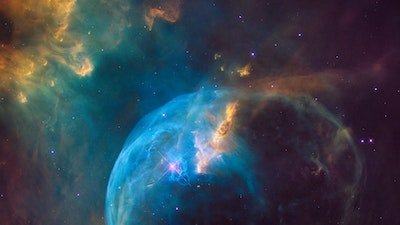
Interpretations of Data Reflect Evolutionary Expectations
Interpretations of data from Deep Evolutionary Exploratory Probe reflect evolutionary expectations.
News Source
- Christian News: “Expert Astronomer Questions New NASA Study on ‘Galaxy Evolution’”
Surprising many scientists who thought galaxies stopped evolving once they were formed, a report published October 5, 2012, in the Astrophysical Journal states that the evolution of galaxies is ongoing. NASA’s Deep Evolutionary Exploratory Probe (DEEP) project is an ongoing survey of galaxies. The latest report interprets data from telescopic and spectroscopic analyses of 544 galaxies, indicating that large disk-shaped galaxies have evolved to a more ordered state over time.
“Astronomers thought disk galaxies in the nearby universe had settled into their present form by about eight billion years ago, with little additional development since,” says lead author Susan Kassin of NASA’s Goddard Space Flight Center. “The trend we’ve observed instead shows the opposite — that galaxies were steadily changing over this time period.”
The survey, which focused on galaxies two to eight billion light years from the Milky Way, indicated that more distant galaxies looked more chaotic, and closer ones more distinct.
The survey, which focused on galaxies two to eight billion light years from the Milky Way, indicated that more distant galaxies looked more chaotic, and closer ones more distinct. The researchers also report, “Massive galaxies are the most well ordered at all times examined, with higher rotation velocities and less disordered motions than less massive galaxies.”1 Our own Milky Way galaxy, they say, “must have gone through the same rough-and-tumble evolution as the galaxies in the DEEP2 sample, and gradually settled into its present state as the sun and solar system were being formed.”
The authors suspect that previously incorrect conclusions—that those galaxies were not changing—were the result of insufficient sampling. “Previous studies removed [did not include] galaxies that did not look like the well-ordered rotating disks now common in the universe today,” explained coauthor Benjamin Weiner. “By neglecting them, these studies examined only those rare galaxies in the distant universe that are well-behaved and concluded that galaxies didn’t change.”
So does this mean the case for galactic evolution is closed? Are astronomers actually looking back through past billions of years and watching galaxies evolving through time?
DEEP2’s data is a collection of actual observations—analogous to snapshots—but those observations are subject to interpretation. Evolutionary thinkers interpret those “snapshots” as evidence of gradual evolution. In fact, even the mission statement of DEEP indicates that obtaining evidence for such evolution is the goal of the project. DEEP2’s “scientific goals are to study the evolution of properties of galaxies and the evolution of the clustering of galaxies compared to samples at low redshift.”2
Dr. Danny Faulkner, a professor of astronomy and physics at the University of South Carolina Lancaster,3 in an interview with Christian News Network, explained this important distinction. Dr. Faulkner said:
This type of observation has really not been tried before, because you need to do spectroscopy — that’s spreading the light out in different wavelengths and measuring emission features in the spectrum. It requires an enormous amount of light and the largest telescopes available.
What I’m concerned with here is that we see basically snapshots. We have photographs of galaxies; we have measurements of motions of gas within them, and people tend to want to interpret them in terms of evolution – going in many cases from less order to more order, which is not the way we see the world work.
The evolutionary interpretation reflects an ongoing violation of the second law of thermodynamics. In nature, systems go from a state of high order to low order, and from higher to lower gravitational energy. Why would galaxies therefore gradually wind themselves up into a more high-energy state? Dr. Faulkner points out that the observations show only “different galaxies with different characteristics at different distances.” He questions the validity of the interpretation claiming their orderliness has been increasing over time, saying:
We see the systematic differences showing up in this study, but is it really going from less order to more order? I have to question that interpretation completely. The only other systematic difference that I’m aware of is that at great distances, galaxies are a bit bluer than they are locally.
As a creationist, I believe that we could interpret these systematic differences in probably a different way. [NASA is] choosing to interpret [their studies] entirely in terms of a gradual evolution of processes. I don’t think that’s necessarily warranted.
Secular astronomers have proposed various theories to explain how stars clustered together as galaxies.
Secular astronomers have proposed various theories to explain how stars clustered together as galaxies. The theory that small clusters have merged to form those we see today, Dr. Faulkner explained, has become popular in the last decade or so. Nevertheless, secular scientists still have no explanation for the perfectly “anthropic” (suitable for man) location of the earth in its solar system, a subject Kassin noted would require further research.
God created the stars in space on the fourth day of Creation Week, according to Genesis 1:16, about 6,000 years ago. And despite their interpretations to the contrary, astronomers have not actually observed the birth of stars, but only stars with different characteristics they interpret to be in different evolutionary stages. Furthermore, God designed the earth to be inhabited (Isaiah 45:18), and therefore provided its unique position, perfectly suited for the life He placed on it.
The DEEP2 observations do not contradict God’s Word, though the evolutionary overlay with which they are interpreted does. Noting the many wonders yet to be discovered in astronomy, Dr. Faulkner concludes:
I don’t have an answer yet for these things, but I’m confident that with time and reflection and God’s leading, we can come up with very physically robust explanations of what we’re seeing here within a creationist framework. I don’t feel threatened at all [by evolutionary claims]. I think this [the DEEP2 observations] can be interpreted in a number of different ways.
Creationist astronomers, like all creation scientists, understand that for an interpretation of scientific observations to have any chance of being correct, it must be in accord with God’s Word and the history of the universe God has there provided.
Further Reading
- New Stars in Bright Blue Galaxy?
- Galaxies—Unexplained Spirals
- Blue Stars
- Galaxy Aglow With New Stars
- The Stars of Heaven Confirm Biblical Creation
- Stellar Evolution, Distant Starlight and Biblical Authority
- Beyond Distant Starlight: Next Steps For Creationist Cosmology
For More Information: Get Answers
Remember, if you see a news story that might merit some attention, let us know about it! (Note: if the story originates from the Associated Press, FOX News, MSNBC, the New York Times, or another major national media outlet, we will most likely have already heard about it.) And thanks to all of our readers who have submitted great news tips to us. If you didn’t catch all the latest News to Know, why not take a look to see what you’ve missed?
(Please note that links will take you directly to the source. Answers in Genesis is not responsible for content on the websites to which we refer. For more information, please see our Privacy Policy.)
Footnotes
- S. Kassin et al., “The Epoch of Disk Settling: z ~ 1 to Now,” Astrophysical Journal 758 (2012):106, doi: 10.1088/0004-637X/758/2/106.
- “THe DEEP2 Redshift Survey,” http://deep.ps.uci.edu/.
- Dr. Danny Faulkner, who will soon be joining the staff at Answers in Genesis, has for 26 years been a professor of astronomy and physics at the University of South Carolina Lancaster. He has a Ph.D. in astronomy from Indiana University as well as a M.S. in physics from Clemson University.

Answers in Genesis is an apologetics ministry, dedicated to helping Christians defend their faith and proclaim the good news of Jesus Christ.
- Customer Service 800.778.3390
- Available Monday–Friday | 9 AM–5 PM ET
- © 2025 Answers in Genesis



